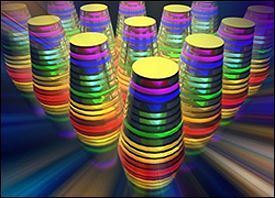More efficient photovoltaic cells are among the possibilities created by a new nanoscale microchip component.
The component, a multilayered waveguide taper array developed at the University at Buffalo, improves a chip’s ability to trap and absorb light. These waveguide tapers slow down and absorb each frequency of light at different places vertically to catch a rainbow of broadband light.
 Each taper is made of ultrathin layers of metal, semiconductors and/or insulators, and absorbs light in metal dielectric layer pairs. By adjusting the thickness of the layers and other geometric parameters, the tapers can be tuned to different frequencies, including visible, NIR, mid-IR, terahertz and microwaves.
Each taper is made of ultrathin layers of metal, semiconductors and/or insulators, and absorbs light in metal dielectric layer pairs. By adjusting the thickness of the layers and other geometric parameters, the tapers can be tuned to different frequencies, including visible, NIR, mid-IR, terahertz and microwaves.
This multilayered waveguide taper array absorbs a range of wavelengths. Courtesy of the University at Buffalo.
The new structure shows promise for improving thin-film photovoltaic cells. Currently, such cells are more flexible and less expensive than traditional solar cells, but they do not absorb as much light. The new array could increase the amount of energy generated in thin-film cells, as it more efficiently absorbs the visible and IR spectrums.
Additional applications for the structure include recycling waste heat that is generated by power plants and other industrial processes, as well as various electronic devices.
“This advancement could prove invaluable for thin-film solar technology as well as recycling waste thermal energy that is a byproduct of industry, and everyday electronic devices such as smartphones and laptops,” said Dr. Qiaoqiang Gan, an assistant professor of electrical engineering at UB.
“It could be useful as an ultracompact thermal absorption, collection and liberation device in the mid-infrared spectrum,” said Dengxin Ji, a doctoral student and the first author.
The structure also could potentially be used as a cloaking material for airplanes, ships and other vehicles to avoid radar, sonar, IR and other forms of detection. It also might serve the relatively new field of advanced computing research called on-chip optical communication.
The work was funded by the National Science Foundation and published in Scientific Reports (doi: 10.1038/srep04498).
For more information, visit: www.buffalo.edu.